useful information
SHIRDI – A PLACE OF FAITH AND WORSHIP
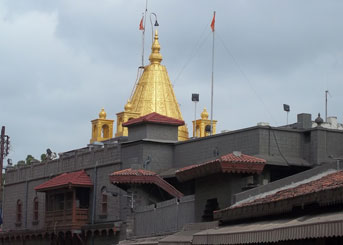 Shirdi, a small rural town in the Rahata Taluk of Ahmednagar district in the Indian state of Maharashtra, is a secular place where all religions are treated as one and a belief in the power of faith & patience is foremost. A place where all heads bow down in prayer, where faith prevails, where hopes are built, where patience pays, and where infinite joy and everlasting contentment abound. Such is the glory of the place which belongs to the Holy Saint, a true repository of wisdom, who pleased all with pious equality and gifted mankind ornaments of humanity and peace by saying “SABKA MALIK EK’.
The footprints of Saibaba have made this town a holy place. Millions of devotees continuously flock there from all over India and abroad. Situated on the Ahmednagar-Manmad highway, Shirdi can be reached from the new railway station at Sainagar, Manmad Junction, Kopargaon and Nagarsul are other nearby railway stations on the Central Railway.
Shirdi, a small rural town in the Rahata Taluk of Ahmednagar district in the Indian state of Maharashtra, is a secular place where all religions are treated as one and a belief in the power of faith & patience is foremost. A place where all heads bow down in prayer, where faith prevails, where hopes are built, where patience pays, and where infinite joy and everlasting contentment abound. Such is the glory of the place which belongs to the Holy Saint, a true repository of wisdom, who pleased all with pious equality and gifted mankind ornaments of humanity and peace by saying “SABKA MALIK EK’.
The footprints of Saibaba have made this town a holy place. Millions of devotees continuously flock there from all over India and abroad. Situated on the Ahmednagar-Manmad highway, Shirdi can be reached from the new railway station at Sainagar, Manmad Junction, Kopargaon and Nagarsul are other nearby railway stations on the Central Railway.
Shirdi is where the holy soul of Shri Satchidanand Sadguru Sainath Maharaj – affectionately known as “Saibaba” rests today.
Shri Saibaba appeared at Shirdi in his human incarnation. For 60 years Baba served mankind and preached his precious teachings to the world from here, and then went for contemplation (Samadhi) in Shirdi itself. The footprints and the deeds of Saibaba have turned this small town into a unique holy place for people of all castes, creeds and religions.
Saibaba delivered the universal slogan of “Shraddha – Saburi”, i.e. Faith and Patience for everyone, from here itself. The place of his ‘Samadhi’ has become a centre-point for innumerable devotees, infusing them with the joy of life. While visiting Shirdi, one experiences complete peace of mind, a strong self—confidence, and a great sense of purpose.
During his contemplation services, Shri Saibaba had consoled his devotees with these words – “After I take Samadhi, my bones will speak from the grave, and people will throng here.” His message is being experienced till today. Shirdi is a convenient place to visit throughout the year, during all seasons.
Nan’s Shirdi is one place where even today all his devotees come with empty hands but filled with Hope, a and go back “Blessed with Contentment with an Everlasting smile of their faces”.
HOLY PLACES IN THE SHRI SAI MANDIR PREMISES
Saibaba’s Samadhi Mandir
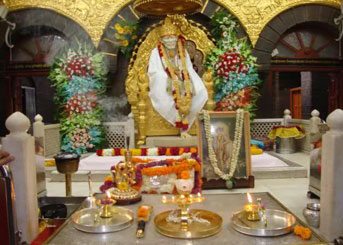
Baba’s Sacred Body has been laid to eternal rest (Samadhi) here. The edifice of this main Mandir was constructed by an ardent devotee Shri Gopalrao Butti of Nagpur with Baba’s blessings. It is therefore also known as “Butti Wada”. Baba’s beautiful life-size idol is installed near His Samadhi in this shrine. All rituals, comprising of Pooja, Abhishek and the four daily Aartis, are performed here. The set of Baba’s original ‘Padukas’ and “Satka’ are kept in the Samadhi Mandir which are used for Thursday Palkhi Procession.
DWARAKAMAI (MASJID)
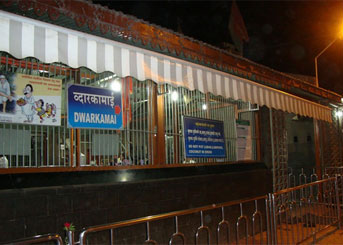 This was Baba’s abode (located within the Samadhi Mandir Complex) continuously for sixty years till he took Samadhi. Baba blessed innumerable devotees here. The Sheela (Stone), on which Baba used to sit, is located in Dwarakamai. The Sacred Fire (Dhuni) lit by baba is also eternally burning here. Baba used to give Sacred Udi (Ash) form this Dhuni to His devotees to fulfill their wishes. Even now, Udi distributed to devotees is from this Dhuni. (‘Grinding Wheel’ and ‘Chula’ on which Baba used to cook food here and distribute it amongst his devotees is also kept here for darshan.
This was Baba’s abode (located within the Samadhi Mandir Complex) continuously for sixty years till he took Samadhi. Baba blessed innumerable devotees here. The Sheela (Stone), on which Baba used to sit, is located in Dwarakamai. The Sacred Fire (Dhuni) lit by baba is also eternally burning here. Baba used to give Sacred Udi (Ash) form this Dhuni to His devotees to fulfill their wishes. Even now, Udi distributed to devotees is from this Dhuni. (‘Grinding Wheel’ and ‘Chula’ on which Baba used to cook food here and distribute it amongst his devotees is also kept here for darshan.
CHAVADI
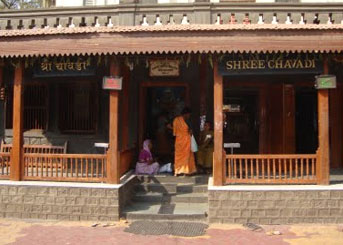
The Chavadi is located close to the Samadhi Mandir Complex on the eastern side. On every alternate day, Baba used to proceed in a procession from Dwarakamai to Chavadi at night and sleep there. Even now, on every Thursday between 9:15 and 10:00 pm, Baba’s Photo, Holy Padukas (Footwear) and Satka (baton) are taken in a palanquin procession to the Chavadi.
GURUSTHAN
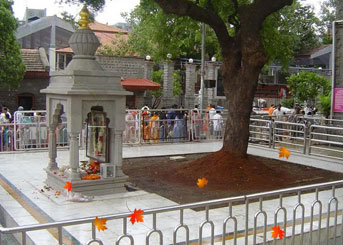
Baba was first spotted here (behind the Samadhi Mandir) when he was a lad of sixteen. Baba used to refer to this spot as His Guru’s (Mentor’s) location and hence known as ‘Gurusthan’ The famous Margosa (neem) tree referred to in the Shri Sai Satcharitra stands here. Devotees believe that if they burn incense here on Thursdays and Fridays all their ailments get cured.
LENDI BAUG

Baba used to go for a stroll in this Baug (Garden) located within the Samadhi Mandir Complex. Nanda-Deep (Sacred Oil Lamp) is continuously kept burning near the Peepal tree planted by Baba himself in this Garden. A small Dutta Mandir is also situated here. Baba’s beloved horse Shyamsunder was laid to eternal rest here. There is also a well, called “Baba’s Shivadi”, in this garden.
MUSEUM HALL
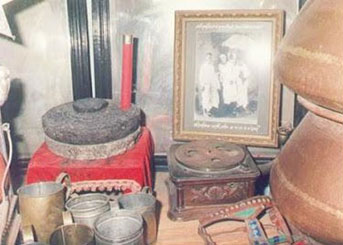
Personal items used by baba during his lifetime like his drinking vessel (Tumbler), Padukas (Footwear), Satka (Baton), Grinder, Gramophones, a Blow of Hukka, Horse Bridle, the Kaphani and Sandals worn by baba and the original photographs of Baba are all kept in the Museum Hall for all Sai devotees.
KHANDOBA MANDIR
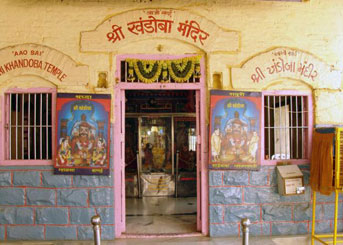 This temp[le is located near the Shri Saibaba Hospital on the Nagar-Manmad Road. The story goes that the marriage party of Chand Patil’s wife’s nephew came to Shirdi and took shelter under the banyan tree located near this temple. When Shri Saibaba, who had accompanied this marriage party, alighted with others in the open ground of this temple, the Pujari (Priest) of the temple welcomes this Young Ascetic with the words “Aao Sai” (Come Sai”).
This temp[le is located near the Shri Saibaba Hospital on the Nagar-Manmad Road. The story goes that the marriage party of Chand Patil’s wife’s nephew came to Shirdi and took shelter under the banyan tree located near this temple. When Shri Saibaba, who had accompanied this marriage party, alighted with others in the open ground of this temple, the Pujari (Priest) of the temple welcomes this Young Ascetic with the words “Aao Sai” (Come Sai”).
IMPORTANT FESTIVALS CELEBRATEDE BY SANSTHAN
SHRI RAMNAVAMI FESTIVAL
Shri Ramnavami festival is being celebrated from the life time of Shri Saibaba. Laths of devotees, not only from Maharashtra but also from all corners of the country come to Shirdi by walk along with the palanquin procession and throng to Shirdi to mark this festival. As per the tradition, the devotees bring the water by Kawad (Holy pot) from Ganga for the holy bath of Shri Saibaba). On the first day of this festival, the procession of Saibaba’s holy book, Veena and Portrait is taken out from Samadhi temple to Dwarakamai temple. Later on, Akhanda Prayan (Continuous reading) of the holy book Shri Sai Satcharitra is done in Dwarakamai. There is a tradition to replace old wheat bag by new one by performing the ritual pooja in Dwarakamai on this day. The sacred flags brought by Shri Ramsane and Shri Nimonkar families are hoisted with procession and by performing pooja. The old flags are replaced. Dwarakamai temple is kept open throughout the night for Akhand Praayan. The chariot procession is taken through the town on this festival day. In addition to this, the main Samadhi temple is also kept open through the night. So, Shej Aarti on the main day of festival and Kakad Aarti on the concluding day are not sung. Rudrabhishek is performed on the third i.e. on concluding day of the festival in Gurusthan temple. Later on Kayla’s Kirtan is delivered at 12 noon and Dahi handi is broken after which the festival is concluded.
SHRI GURUPOURNIMA FESTIVAL
Guru-Shishya (Teacher-Student) tradition has an ancient history. TO pay the respect and gratitude towards our teachers, Ashadhi Pournima is celebrated as “Gurupournima”. It was celebrated in Shirdi during life time of Shri Saibaba. So, this day has a special importance. The devotees having faith in Shri Saibaba used to come to Shirdi on this day to pay their obeisance and take Samadhi’s darshan. Lakhs of devotees also come by walk along with the palanquin procession to mark this day in Shirdi. The procession including the holy book, Veena and Saibaba’s portrait is taken out from Samadhi temple to Dwarakamai temple on the first day of the festival. Soon after, the Akhand Prayan (Continuous reading) the holy book Shri Saisatcharitra is started in Dwarakamai. On the main day of the festival, the procession of Shri Saibaba’s Chariot is taken out through the town. Dwarakamai is kept open through the night for Akhand Prayan on the first day. Palanquin procession is taken out in the night. Samadhi temple is kept open on the main day of the festival for darshan to the devotees. So Shej Aarti and Kakad Aartis are not sung on the main day of the festival. Rudrabhishek is performed on the third day in Gurusthan temple. Later on Kalya’s Kiran is delivered at 12 noon and Dahi handi is broken after which the festival is concluded.
SHRI PUNYATITHI FESTIVAL
Vijayadashimi (Dussehara) is the day of Saibaba’s Punyatithi celebration. Punyatithi is the day to remember that great saints merged into divine self. Dussehara is also one of he days of three and a half auspicious moments. Simmolangham is done on the same day. So, Shri Saibaba liked this day the most. (So, he selected this day for his merger in self) Aradhana Programme of Shri Saibaba is done on this day as per tradition. The procession of Bhiksha Zoli is taken out through the town on this day. Lakhs of devotees from all corners of the country come to Shirdi to arm this festival. The procession of Saibaba’s Veena, holy book and portrait is taken out from Samadhi temple to Dwarakamai temple on the first day of the festival. On the main day of the festival, the Simmolanghan procession is taken out from Samadhi temple to the Khandoba temple at 5 pm. Dwarakamai is kept open throughout night on the first day for Akhand Parayan. Palanquin procession is taken out in the night. Samadhi temple is kept open through the night on the main day for darshan. SO, Shej Aarti and Kakad Aartis are not sung on the main day of the festival. Rudrabhishek is performed on the third day in Gurusthan temple. Later on Kalya’s Kirtan is delivered at 12 noon and Dahi handi is broken after which the festival is concluded.
The Daily Program at Saibaba Samadhi Mandir
Program Time
